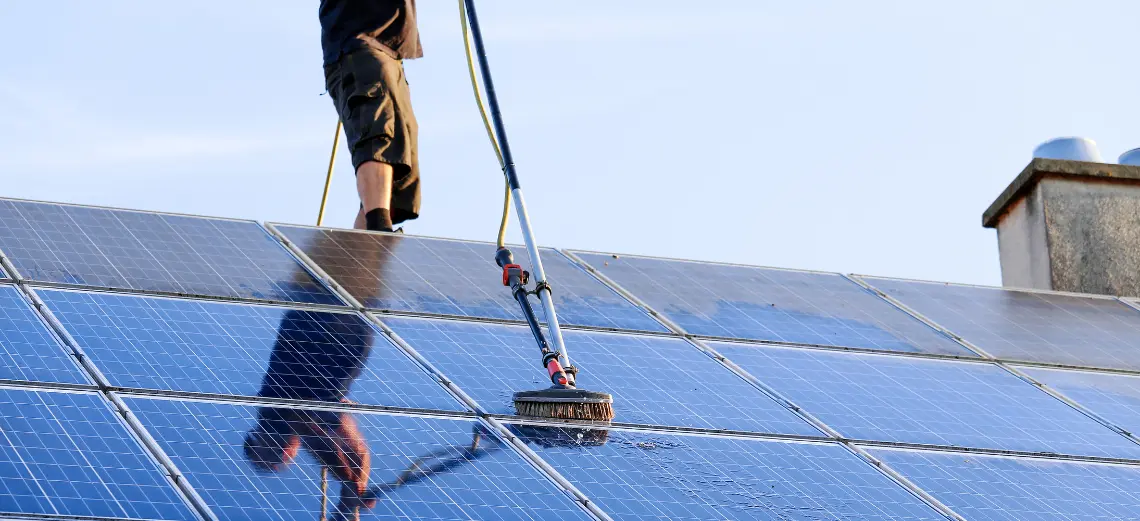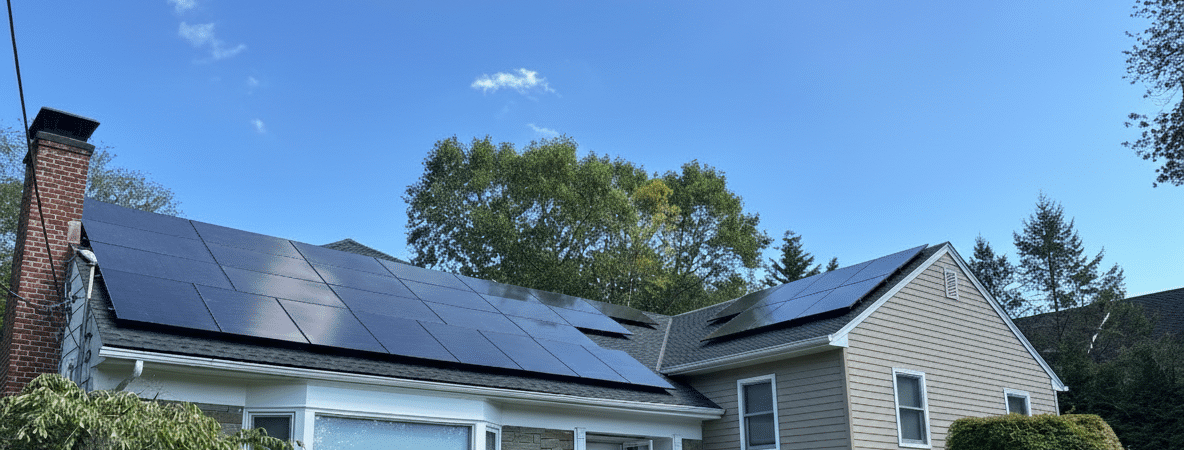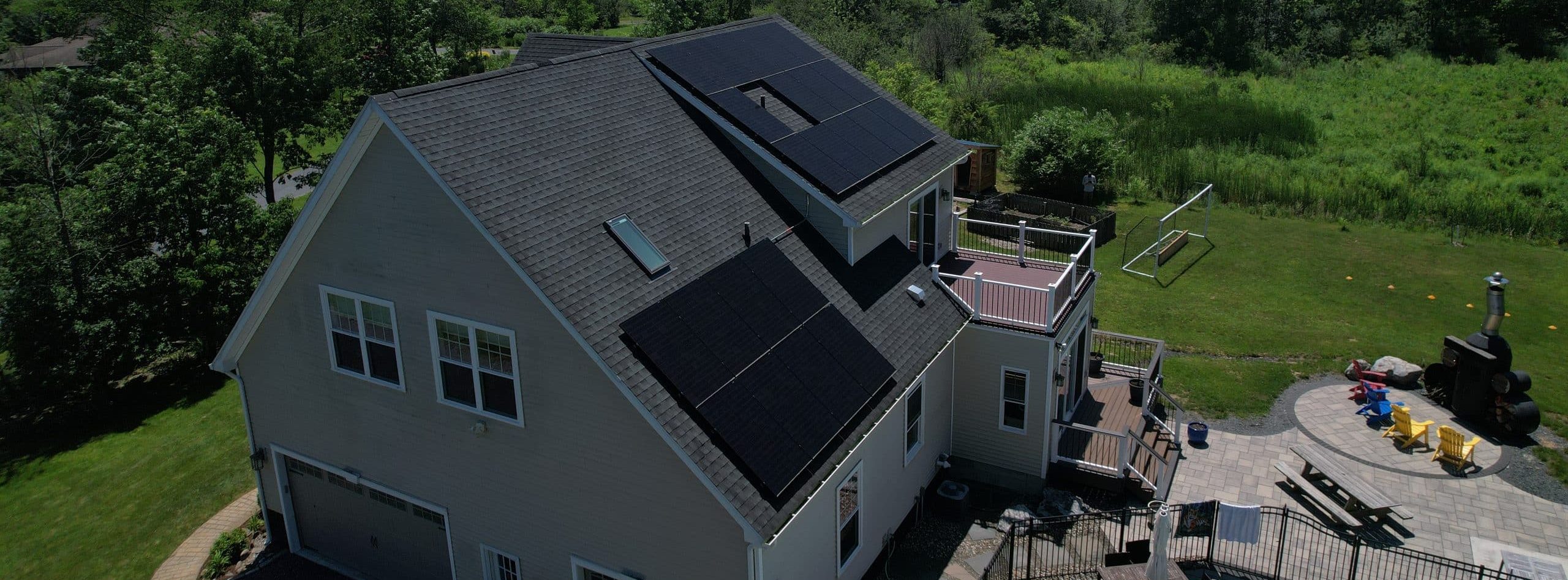According to the National Renewable Energy Laboratory, the productivity of solar panels decreases by 0.8% year on average, which implies they could provide a bit less power. This fact makes solar panel maintenance essential to increase the efficiency as well as the lifespan of the solar panels, which leads to a reduced annual deterioration rate.
Here is our guide, including a solar panel maintenance checklist and tips for residential or commercial solar panel maintenance.
Significance of Solar Panel Maintenance
Solar panels have a long lifespan, but they’ll perform at their peak if you know how to maintain them. A number of factors, including dust, dirt, pollen, and debris, can build up on the surface of solar panels. By blocking sunlight and preventing the solar cells from receiving energy, these particles can dramatically lower the efficiency of your solar panels. Maintaining the panels extends their lifespan, assures top performance, and maximizes the return on your investment.
Solar Panel Maintenance also offers advantages in terms of the following:
Maximizing Efficiency
The capacity of solar panels to absorb sunlight and transform it into electricity can be reduced by dust, grime, and other material that might cling to their surface. Maximum productivity and increased energy generation are guaranteed and achieved by regular cleaning.
Increased Lifespan
The lifespan of solar panels usually is 25 to 30 years. Regular maintenance of solar panels keeps the panels functioning correctly for a longer time, allowing years of sustainable energy generation.
Early Diagnosis
Early detection of any fault or problem with the solar panels is possible through routine inspections. Solar panel maintenance enables prompt repairs, timely diagnosis, and reduces the chance of costly downtime or significant concerns.
Staying Under Warranty
Many solar panel installers and manufacturers provide warranties, which need routine upkeep of solar panels to stay under the validity period. Solar panel maintenance makes sure you benefit from warranty coverage when required.
Solar Panel Maintenance Checklist: Keep Your Solar System Shining Bright
Due to the lack of moving parts, solar panels require less maintenance. Regular upkeep ensures that your solar system performs at its best, enabling you to benefit from renewable energy fully. The following solar panel maintenance checklist should be followed to keep your solar panels in peak shape :
Solar Panel Servicing
We advise that you get the system inspected by a professional at least once in every five to ten years. By doing so, you can ensure that your solar panels produce enough energy to reduce expenses while staying on top of unpleasant financial shocks.
Check for Issues
Check your solar panels for any dirt accumulation or mounting system issues, such as loose bolts, preferably with binoculars. At least twice a year, take a brief peek. Additionally, if you observe a rapid decline in the output of your solar panels, it can be an indication of a problem.
Get Your Solar Panels Cleaned
Solar panels require cleaning approximately every five years unless they get unusually dirty. The best approach to clean your solar panels is from the ground using a hose. Avoid using high-pressure water sprayers or detergents since doing so may cancel your warranty. Make sure to clean dust & pollen from the solar panels during summer and keep an eye out for debris in winter.
Eliminate Possible Threats
In order to prevent any risks to the panels, any overhanging branches should be cut down. Additionally, make sure that you keep pests like pigeons and squirrels away from your solar panel frames. The easiest method to accomplish this is to use mesh netting to protect your solar panels from birds.
Keep Solar Panels Away from Shade
If your panels are shielded from the sunshine, their ability to produce electricity will suffer. It is essential to keep any neighboring trees trimmed and keep ivy away from your solar panels for the proper functioning of the solar panel system.
Verify the Inverters’ Flashing Green Lights
There are no defects in your solar energy system while the LED on your inverters is blinking green. If they are not flashing, it may indicate a more serious problem that, if ignored, might cost you a lot of money. Remember that inverters require replacement more frequently than solar panels do, which is once every 10 years.
Maintain Notes
When doing repairs, cleaning, or replacements on your panels, be sure to maintain a record of the changes or repairs made. This can assist service members in identifying the root of problems down the road and help save time.
Keeping the Solar panel maintenance checklist in mind will help you not only increase the productivity of the solar panels but will also increase their lifespan.
Another important point to remember if you are considering maintenance of your solar panels is that the solar panel maintenance cost depends upon a number of factors like the number of solar panels, age of solar panels, issues and damage caused, etc. As per NREL (National Renewable Energy Laboratory), Solar panel maintenance cost is $31 per kilowatt (kW).This indicates that the expected annual operating and maintenance costs for a 6 kW system are less than $200.
A Comprehensive Solar Panel Maintenance Checklist
1. Ensure Panel Security and Cleanliness
Regularly check that your solar panels are securely mounted and free from dirt or debris. Accumulations of dust, sap, or leaves can hinder energy production. It’s essential to clean them during cooler parts of the day, like mornings or late afternoons, to prevent thermal shock. Use soft brushes or sponges to clean, avoiding harsh materials that could scratch the surface.
2. Monitor Power Output
Track your solar system’s energy production consistently. To gauge their performance, record output monthly around noon, ideally over a year, to identify trends and any dips in efficiency. This data can be instrumental in forecasting energy generation and planning for future maintenance or upgrades.
3. Follow Manufacturer’s Guidelines
Different brands have specific maintenance recommendations. Review the manual specific to your solar panels to understand their cleaning frequency, weight limitations, and any materials that should be avoided. Additionally, those in colder climates should consider insulating solar trackers during winter to prevent damage from freezing conditions.
4. Inspect for Corrosion and Damage
Conduct bi-annual checks for rust, aging, and other damages. This is especially crucial for installations near coastal areas where corrosion risks are higher. Ensure the rear sheet of the panels is intact to avoid water intrusion which can cause irreparable damage and safety hazards.
5. Examine Wiring and Connections
Inspect connections and wiring regularly to detect any damage that could lead to power loss or safety hazards. If issues are found, such as water seeping into the system that might cause short circuits, contact a professional; do not attempt repairs yourself.
6. Keep Isolator Switches Accessible
In emergencies, the isolator switch should be easy to access. Ensure the area around it is clear to allow manual disconnection of the solar power system when necessary, which is often required during maintenance or repairs.
7. Conduct Routine Electrical Checks
Regularly inspect your system, focusing on the inverter panel for any electrical irregularities. If performance declines—for instance, if the inverter indicator changes from green to red—it might be time for repairs or upgrades. Understanding fault codes can help pinpoint issues promptly.
8. Maintain a Detailed Logbook
Document all maintenance activities and repairs in a logbook. Include inspection dates and details of any component replacements, ensuring a comprehensive maintenance history that can be invaluable for troubleshooting and future servicing decisions.
9. Tackle Repairs Immediately
Should any issues arise, promptly contact a solar panel professional to assess and repair. Addressing minor issues quickly can prevent them from escalating, potentially requiring more extensive repairs or even replacements.
10. Schedule Monthly Inspections
Regular monthly inspections help maintain optimal performance and quickly identify any potential issues caused by environmental factors like wind or temperature fluctuations. Regular checks enhance efficiency and extend the lifespan of your solar panels, maximizing return on investment.
Tips for Solar Panel Maintenance
- Install automatic cleaners that function like sprinkler systems if installing your roof to clean your panels is not an option for you.
- Do not install solar panels yourself. Hiring a qualified installation will decrease the likelihood of any complications.
- Consider the long term. Although we are aware that solar panel repairs might be expensive, we aim to avoid any hasty solutions or quick fixes.
Pro tip: Know more about solar panel installation in locations like Slingerlands, Catskill and Valatie.
What Are the Signs That a Solar Power System Needs Maintenance?
Owning a solar power system usually means minimal upkeep beyond periodic inspections and cleaning. Yet, there are certain indicators that your system might require attention sooner than planned. Recognizing these signs early can prevent smaller issues from escalating.
- Decreased Energy Output: One of the most apparent signals is a drop in energy production. If your solar panels are not generating sufficient electricity to meet your needs or if there is an unexpected spike in your energy bills, it might be time to investigate further.
- Physical Damage: Inspect your panels for visible damages such as cracks, chips, or any other physical deformities. Severe weather events can sometimes lead to such issues, necessitating immediate repair.
- Inverter Issues: The inverter in your solar system often signals its performance through indicator lights or digital displays. A red or orange light might suggest a malfunction that needs swift attention.
- Unusual Weather Effects: After a storm or heavy snowfall, check your panels for debris buildup or potential damage. Unattended, these can affect the efficiency of your panels.
- Wiring Problems: Loose or damaged wiring can also be a problem. This may not always be visible but can result in the system inconsistently operating.
- Alarming Auditory Cues: Listen for unusual sounds near your solar equipment. Buzzing or humming can indicate a problem requiring professional assessment.
By keeping a close eye on these signs, you can ensure your solar power system remains highly efficient and continues to serve your energy needs without interruption.
What Services Can Be Expected from Solar Maintenance Providers?
When it comes to maintaining your commercial solar panels, a robust range of services is essential to keep the system operating at peak performance. Here’s what you can typically expect from solar maintenance providers:
- Regular Inspections: Routine check-ups are crucial to identify any issues that might affect the efficiency and output of your solar panels. These inspections aim to catch potential problems early, ensuring minimal disruption to your solar energy production.
- Cleaning Services: Accumulation of debris like dust and dirt can significantly reduce the efficiency of solar panels. Maintenance providers offer cleaning services to keep your panels clear and functional, enhancing their energy capture.
- System Repairs: Whether it’s minor damage from weather events or significant issues with components like inverters or wiring, professional repair services are vital. Providers can diagnose faults and conduct necessary repairs, safeguarding your investment.
- Performance Monitoring: Many companies offer ongoing monitoring services to track the performance of your solar system. This service helps in early detection of inefficiencies, allowing for timely interventions.
- Component Replacement: As parts of your solar system age, they may need replacing. Maintenance providers ensure that components like inverters and batteries are working efficiently or swapped out when necessary to maintain optimal system performance.
Choosing the right provider ensures that whether you’re managing a commercial enterprise, agricultural operation, or a large utility solar setup, your system remains efficient and productive.
How Much Does It Cost to Maintain a Solar Power System?
Maintaining a solar power system is generally affordable, even when enlisting professional help, which is advisable since these systems are typically installed on roofs.
Typical Costs
On average, you can expect to spend between $150 and $450 annually. This range covers the cost of hiring a professional to inspect and clean the panels once a year. Regular inspections are crucial to ensure the efficient operation of your solar energy investment.
Additional Expenses
If your solar panels accumulate dirt or debris more frequently, or if there’s damage to the system, the maintenance costs may increase. Regular upkeep helps in preemptively addressing minor issues that could escalate into bigger, more costly repairs.
Service Plans and Packages
Different installers offer varying maintenance options. Some include maintenance in the initial purchase, while others provide service plans for an extra fee. These plans often cover routine cleaning and system checks to maintain peak performance. Always check with your installer to understand what’s included in your purchase and the details of any additional service agreements.
In summary, while the cost of maintaining a solar power system can vary, it typically remains manageable and is essential for getting the most out of your solar investment.
How Often Should You Inspect Your Commercial Solar Panels?
To keep your commercial solar panels operating at peak efficiency, regular inspections are crucial. Ideally, these panels should undergo a monthly inspection routine.
Why Monthly Inspections?
- Environmental Exposure: Solar panels face constant environmental challenges. Wind, rain, hail, and fluctuating temperatures can lead to gradual wear and even damage.
- Early Problem Detection: Regular checks help spot issues like physical damage or performance dips early before they escalate into expensive repairs.
- Maximized Efficiency: Consistent inspections ensure your panels are generating the expected energy output, thus optimizing your return on investment.
By adhering to a monthly inspection schedule, you not only extend the lifespan of your solar panels but also secure a steady and efficient energy supply for your business.
Conclusion
Embracing a proactive solar panel maintenance checklist is your key to unlocking the full potential of clean and renewable energy. By following this comprehensive guide, you ensure your solar system’s longevity and optimal performance and contribute to a greener planet. Regular cleaning, vigilant inspection, and thoughtful care of electrical components and connections are your tools for harnessing sunlight’s power effectively.
Remember, a well-maintained solar panel system saves money and propels you towards a more sustainable and environmentally conscious future. If you want to get solar panels installed for residential or commercial purposes, Feel free to contact us. We at Infinity Energy provide professional and smooth solar panel installation services to empower communities to thrive in an eco-conscious world. Join us now to begin your solar adventure!












